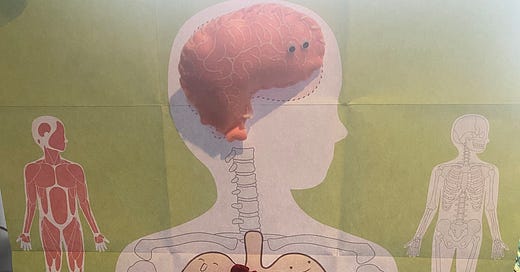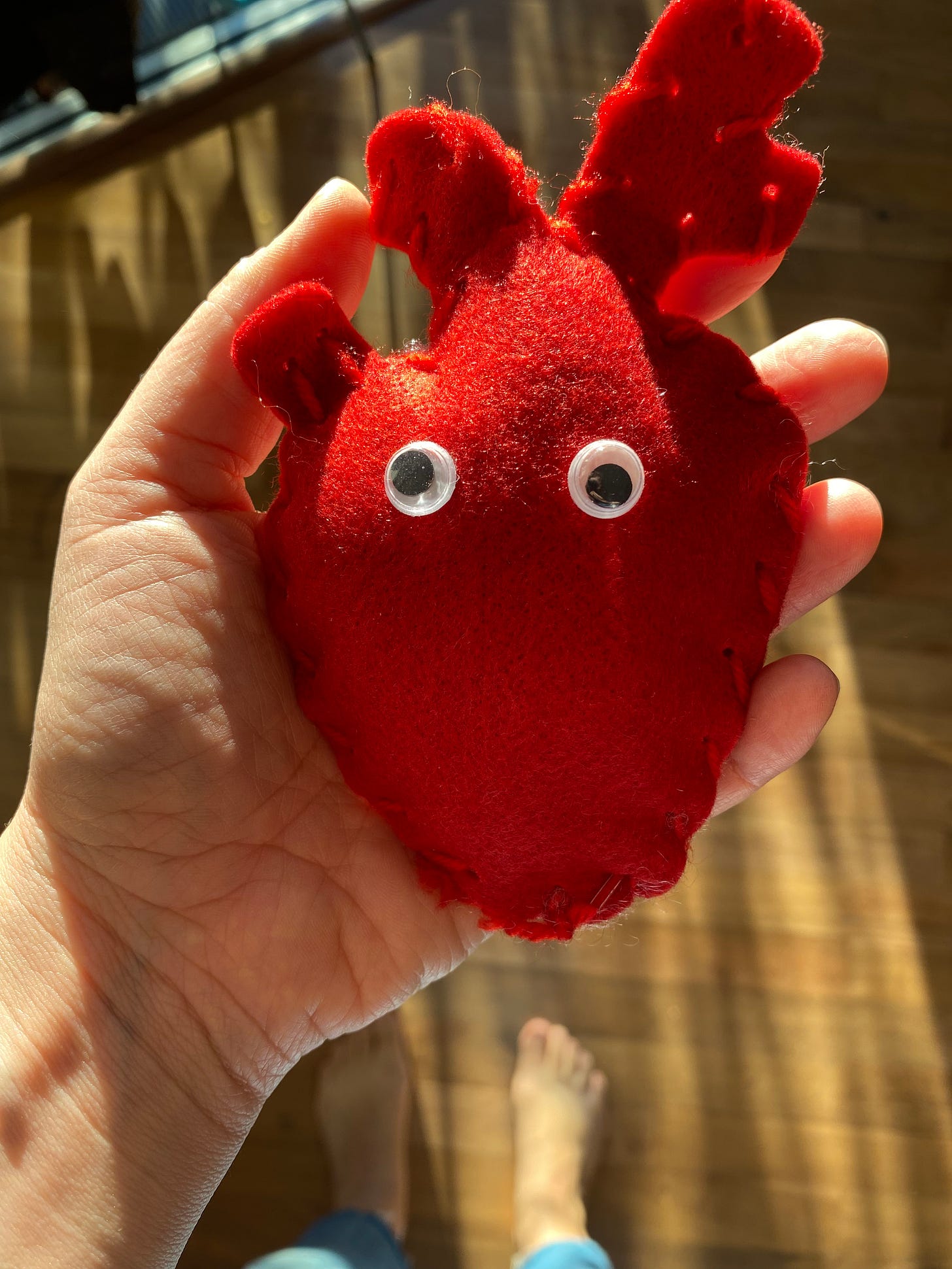The Language of the Heart
On language & the body, piggybacking hearts and multilingual emotions. Plus, links on "raising good humans", war metaphors & teen dreams.
Last week, my children and I made a felt heart. The activity was part of a lesson on body systems and included a brain and a stomach. For each organ, I started the threading, making a little knot so the string would not escape. Then I showed my children how to thread the shoelace in one side of a hole and out the other. Before closing the organs, we stuffed each one with cloud-like fuzz, making it three-dimensional. Each organ puffed out like a little character, complete with googly eyes my son glued on. As we put the little organs on the body poster, my daughter alerted me that the heart was “wrong”. If I flipped the heart, the googly eyes would be on the wrong side, looking in, rather than out. We left the heart the way it was, the pathway of the blood flow reversed, an extra artery poking out.
Languages live in the mind but also, the body. I study and write about language and emotion all the time and yet, I find it incredibly difficult to articulate what that connection means. For one, it is complex because everyone’s experience with language and emotion may be different. Some linguists have explored the link between language and emotion through affective processing, or how bodies react to stimuli.
In a 2003 study,1 researchers showed Turkish-English bilinguals a variety of words and then, examined electrical conductivity of the skin through fingertip electrodes. The study participants exhibited stronger physical responses to Turkish words, especially taboo words, and childhood reprimands. Some of the participants said they could hear the voices of Turkish relatives using the same reprimands from their childhoods. Affective processing in a first language may be deeper than in languages learnt later in life2. This is why you often hear multilinguals refer to a “the language of the heart” when talking about a childhood language, especially if they are not as proficient in a language learnt later in life.
But as other studies have shown, as well as the work of writers who write in a language that is not their first, the language of the heart is not always the first language someone learnt. Yes, as in (not) the mother tongue. I attended a fascinating seminar last week by a university colleague3 about how some survivors of torture and asylum seekers in the UK use English, their second or subsequent language, for therapy. There is a detachment from English as it is not a first language, and often, not the language the trauma to the body and mind took place. As one of the study participants noted, “English enables them to revisit their pain.”
“When the heart speaks, the mind finds it indecent to object.”
― Milan Kundera, The Unbearable Lightness of Being
Not long ago, I read an old article about 16-year-old Hannah Clark, who is the first person in Britain to receive a new heart only to have it later removed and recover. Born with a rare heart condition, Clarke was two when she had a five-month-old heart grafted to her own. For 10 and a half years, Clarke had two hearts, the second heart keeping her alive while her first heart was able to heal. The second heart was “piggybacking” the first. There were complications with the donation so at 12, Clarke had the second heart removed and the last time Clarke was in the media, she was a healthy 18-year-old with her original heart. (I was unable to find an update on Clarke since the 2011 article.) The reason behind using two hearts in this way is that if the transplanted heart fails or is rejected, the patient’s own heart could at least sustain life until another transplant is available.
Perhaps languages of the heart in multilinguals who use both languages regularly and feel an emotional connection with each one are also piggybacking off one another. And when one fails, the other steps in. I feel this with my children in how we communicate recently, mixing languages, fighting to get them to use the minoritized language over the majority one, going back and forth. And yet, the two languages, the two hearts are always there, in a way taking care of one another. Or, at least I hope.
A few more things & links:
I finally listened to Mona Chalabi on Longreads and whoa. As a freelance journalist, I am in awe of her bravery and strength and her conviction to do what is right. It is a complex situation and story but if you are interested in journalism, or simply what it is to live now, have a listen. I can’t stop thinking about the part where she opens her Instagram and tells the interviewer, how one second, she is seeing dead children in Palestine and then the next, someone is selling her clothing or something along those lines. I feel this so acutely now.
I love Kathryn Jezer-Morton’s Brooding column in The Cut. I don’t always agree with her, but she always makes me think of things I have never considered and that is a journalism gift. Her recent essay on why the phrase “raising good humans” bothers her was interesting. Again, I don’t agree with everything she says because the phrase doesn’t bother me as much as it bothers her, and I do think there are some really shitty humans out there so attempting to raise “good ones” is a thing, but it was an interesting take. I will one day write a long essay about secular home education, or as Jezer-Morton calls it, the “homeschooling space” (the latter usually has a religious influence) as I’ve noticed lots of writers go there with only a very specific momfluencer lens. I think at this point, we should all be skeptical of government institutions and lots of home-ed kids I know are addicted to sugar, screens and social justice in the best possible way! (I think the home-ed space/discussion is also heavily influenced by a UK-North America difference, at least for me.)
I am going to see Zadie Smith talk this week and I loved this essay about being a teenager and having a teenager. The parts about her mom hit me hard and I laughed out loud when she made fun of changing her name from Sadie to Zadie.
War metaphors in beauty marketing. But also, war metaphors in everything from love and politics to sports and health.
Harris, Catherine L., Ayşe Ayçíçeğí, and Jean Berko Gleason. "Taboo words and reprimands elicit greater autonomic reactivity in a first language than in a second language." Applied Psycholinguistics 24.4 (2003): 561-579.
“Later in life” is hard to quantify and know exactly what this means and when/if there is a cut-off point. Linguists have struggled with this for a long time as there are so many other variables.
Cook, Sally Rachel, and Jean-Marc Dewaele. "‘The English language enables me to visit my pain’. Exploring experiences of using a later-learned language in the healing journey of survivors of sexuality persecution." International Journal of Bilingualism 26.2 (2022): 125-139.






Beautifully written. When I moved to the US and stopped using Spanish for a couple of years--I worked in English during that time--my first language would only come out in expletives when I stubbed my toe 😂😂
Do you homeschool? I didn’t realize. We’re a secular homeschool family as well. Just a couple of years into it, brought on in part by the pandemic, it’s definitely been an experience but overall I like learning/re-learning with my kids.